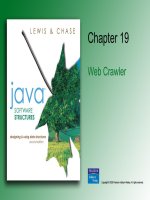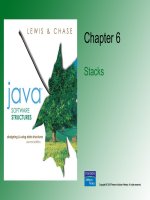Bài giảng Cấu trúc dữ liệu_Phần Stack
Bạn đang xem bản rút gọn của tài liệu. Xem và tải ngay bản đầy đủ của tài liệu tại đây (1.52 MB, 45 trang )
Chapter 6
Stacks
Copyright © 2005 Pearson
Addison-Wesley. All rights
reserved.
6-2
Chapter Objectives
•
Examine stack processing
•
Define a stack abstract data type
•
Demonstrate how a stack can be used to
solve problems
•
Examine various stack implementations
•
Compare stack implementations
Copyright © 2005 Pearson
Addison-Wesley. All rights
reserved.
6-3
Stacks
•
A stack is a linear collection whose elements
are added and removed from one end
•
A stack is LIFO – last in, first out
•
The last element to be put on the stack is the
first element to be removed
•
A stack is usually depicted vertically, with
additions and deletions occurring at the top
of the stack
Copyright © 2005 Pearson
Addison-Wesley. All rights
reserved.
6-4
FIGURE 6.1
A conceptual view of a stack
Copyright © 2005 Pearson
Addison-Wesley. All rights
reserved.
6-5
FIGURE 6.2
The operations on a stack
Copyright © 2005 Pearson
Addison-Wesley. All rights
reserved.
6-6
FIGURE 6.3
The StackADT interface in UML
Copyright © 2005 Pearson
Addison-Wesley. All rights
reserved.
6-7
Listing 6.1
Copyright © 2005 Pearson
Addison-Wesley. All rights
reserved.
6-8
Using Stacks
•
Stacks are particularly helpful when solving
certain types of problems
•
Consider the undo operation in an
application
–
keeps track of the most recent operations
in reverse order
Copyright © 2005 Pearson
Addison-Wesley. All rights
reserved.
6-9
Postfix Expressions
•
Let's examine a program that uses a stack to
evaluate postfix expressions
•
In a postfix expression, the operator comes
after its two operands
•
We generally use infix notation, with
parentheses to force precedence:
(3 + 4) * 2
•
In postfix notation, this would be written
3 4 + 2 *
Copyright © 2005 Pearson
Addison-Wesley. All rights
reserved.
6-10
Postfix Expressions
•
To evaluate a postfix expression:
–
scan from left to right, determining if the next
token is an operator or operand
–
if it is an operand, push it on the stack
–
if it is an operator, pop the stack twice to get the
two operands, perform the operation, and push
the result onto the stack
•
At the end, there will be one value on the
stack, which is the value of the expression
Copyright © 2005 Pearson
Addison-Wesley. All rights
reserved.
6-11
FIGURE 6.4 Using a stack to
evaluate a postfix expression
Copyright © 2005 Pearson
Addison-Wesley. All rights
reserved.
6-12
Postfix Expressions
•
To simplify the example, let's assume the
operands to the expressions are integer
literals
•
Our solution uses an ArrayStack, though
any implementation of a stack would suffice
Copyright © 2005 Pearson
Addison-Wesley. All rights
reserved.
6-13
Listing 6.2
Copyright © 2005 Pearson
Addison-Wesley. All rights
reserved.
6-14
Listing 6.2 (cont.)
Copyright © 2005 Pearson
Addison-Wesley. All rights
reserved.
6-15
Listing 6.3
Copyright © 2005 Pearson
Addison-Wesley. All rights
reserved.
6-16
Listing 6.3 (cont.)
Copyright © 2005 Pearson
Addison-Wesley. All rights
reserved.
6-17
Listing 6.3 (cont.)
Copyright © 2005 Pearson
Addison-Wesley. All rights
reserved.
6-18
Listing 6.3 (cont.)
Copyright © 2005 Pearson
Addison-Wesley. All rights
reserved.
6-19
Listing 6.3 (cont.)
Copyright © 2005 Pearson
Addison-Wesley. All rights
reserved.
6-20
FIGURE 6.5 A UML class diagram
for the postfix expression program
Copyright © 2005 Pearson
Addison-Wesley. All rights
reserved.
6-21
Using Stacks - Traversing a
Maze
•
A classic use of a stack is to keep track of
alternatives in maze traversal or other trial
and error algorithms
•
Using a stack in this way simulates recursion
–
Recursion is when a method calls itself
either directly or indirectly
Copyright © 2005 Pearson
Addison-Wesley. All rights
reserved.
6-22
Using Stacks - Traversing a
Maze
•
Run-time environments keep track of method
calls by placing an activation record for each
called method on the run-time stack
•
When a method completes execution, it is
popped from the stack and control returns to
the method that called it
–
Which is now the activation record on the top of
the stack
Copyright © 2005 Pearson
Addison-Wesley. All rights
reserved.
6-23
Using Stacks - Traversing a
Maze
•
In this manner, we can traverse a maze by
trial and error by using a stack to keep track
of moves that have not yet been tried
Copyright © 2005 Pearson
Addison-Wesley. All rights
reserved.
6-24
Listing 6.4
Copyright © 2005 Pearson
Addison-Wesley. All rights
reserved.
6-25
Listing 6.4 (cont.)









